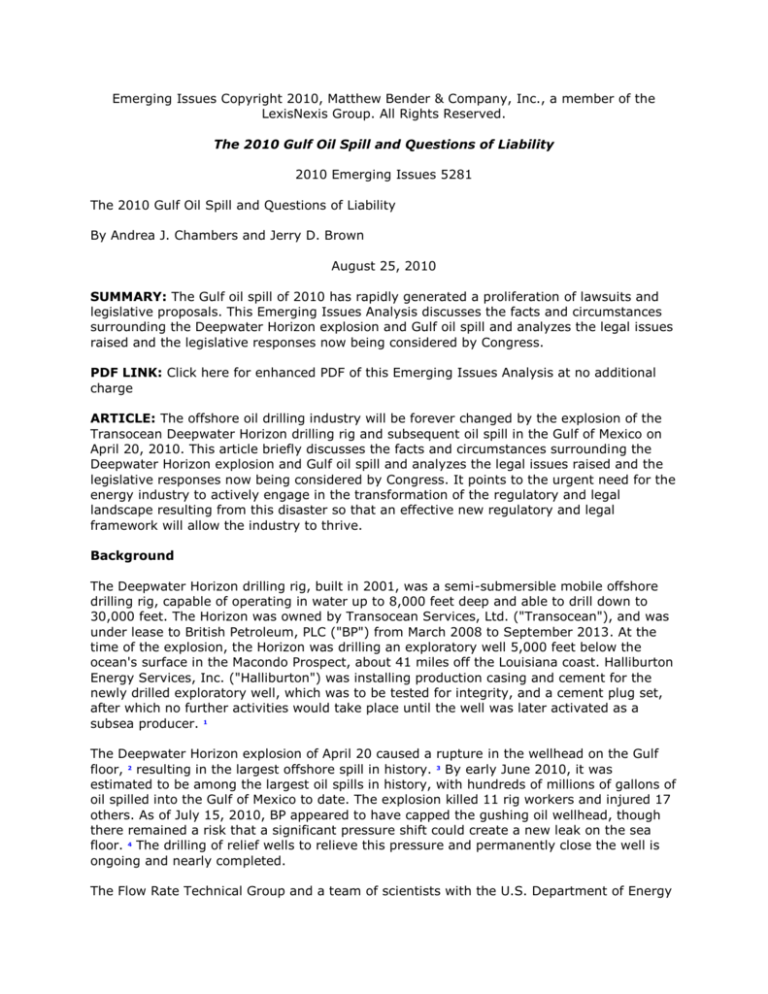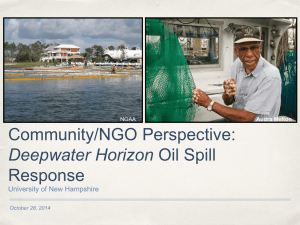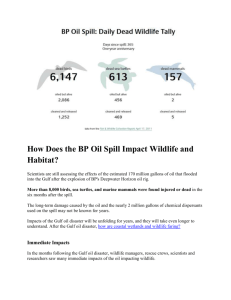
Emerging Issues Copyright 2010, Matthew Bender & Company, Inc., a member of the
LexisNexis Group. All Rights Reserved.
The 2010 Gulf Oil Spill and Questions of Liability
2010 Emerging Issues 5281
The 2010 Gulf Oil Spill and Questions of Liability
By Andrea J. Chambers and Jerry D. Brown
August 25, 2010
SUMMARY: The Gulf oil spill of 2010 has rapidly generated a proliferation of lawsuits and
legislative proposals. This Emerging Issues Analysis discusses the facts and circumstances
surrounding the Deepwater Horizon explosion and Gulf oil spill and analyzes the legal issues
raised and the legislative responses now being considered by Congress.
PDF LINK: Click here for enhanced PDF of this Emerging Issues Analysis at no additional
charge
ARTICLE: The offshore oil drilling industry will be forever changed by the explosion of the
Transocean Deepwater Horizon drilling rig and subsequent oil spill in the Gulf of Mexico on
April 20, 2010. This article briefly discusses the facts and circumstances surrounding the
Deepwater Horizon explosion and Gulf oil spill and analyzes the legal issues raised and the
legislative responses now being considered by Congress. It points to the urgent need for the
energy industry to actively engage in the transformation of the regulatory and legal
landscape resulting from this disaster so that an effective new regulatory and legal
framework will allow the industry to thrive.
Background
The Deepwater Horizon drilling rig, built in 2001, was a semi-submersible mobile offshore
drilling rig, capable of operating in water up to 8,000 feet deep and able to drill down to
30,000 feet. The Horizon was owned by Transocean Services, Ltd. ("Transocean"), and was
under lease to British Petroleum, PLC ("BP") from March 2008 to September 2013. At the
time of the explosion, the Horizon was drilling an exploratory well 5,000 feet below the
ocean's surface in the Macondo Prospect, about 41 miles off the Louisiana coast. Halliburton
Energy Services, Inc. ("Halliburton") was installing production casing and cement for the
newly drilled exploratory well, which was to be tested for integrity, and a cement plug set,
after which no further activities would take place until the well was later activated as a
subsea producer. 1
The Deepwater Horizon explosion of April 20 caused a rupture in the wellhead on the Gulf
floor, 2 resulting in the largest offshore spill in history. 3 By early June 2010, it was
estimated to be among the largest oil spills in history, with hundreds of millions of gallons of
oil spilled into the Gulf of Mexico to date. The explosion killed 11 rig workers and injured 17
others. As of July 15, 2010, BP appeared to have capped the gushing oil wellhead, though
there remained a risk that a significant pressure shift could create a new leak on the sea
floor. 4 The drilling of relief wells to relieve this pressure and permanently close the well is
ongoing and nearly completed.
The Flow Rate Technical Group and a team of scientists with the U.S. Department of Energy
estimate that roughly 4.9 million barrels of oil have been released as a result of the Gulf oil
spill. The flow rate of released oil was first estimated at 62,000 barrels a day at the start of
the spill in late April. This estimate was reduced to 53,000 barrels a day immediately before
the well was sealed on July 15. 5 The resulting oil slick covers at least 2,500 square miles. 6
Scientists have also reported immense underwater plumes of oil not visible from the
surface. 7
To date, almost 116,000 claims have been submitted to BP and more than 67,500
payments have been made, totaling $207 million. 8 Including the cost of the spill response,
containment, relief well drilling, grants to the Gulf states, payment of claims, and U.S.
government costs, BP claims to have already spent $3.95 billion. 9 The spill has the potential
to cause extensive damage both to marine and wildlife habitats on the Gulf coast and to the
Gulf's fishing and tourism industries. The U.S. government named BP as the responsible
party for the oil spill. 10
Legal Issues
The Gulf oil spill has rapidly generated a proliferation of lawsuits, raising numerous legal
issues with lasting wide-ranging consequences, not only for the litigating parties but for the
energy industry as well.
The number of claims is expected to grow considerably. Moreover, in addition to potential
liability for personal injury and property damage claims, numerous other federal laws are
implicated in the Deepwater Horizon explosion and the resulting oil spill, raising numerous
and serious potential liabilities for BP, Transocean and Halliburton. Moreover, issues have
been raised about the government's oversight of offshore drilling—specifically, possible
failures to properly regulate BP, Transocean and Halliburton. 11
Further, the Obama administration's response to the oil spill has been subjected to legal
challenge. Specifically, a six-month moratorium against new offshore drilling in the Gulf of
Mexico issued by the U.S. Department of the Interior ("DOI") was challenged in a complaint
for an injunction on the grounds that the DOI failed to establish a proper and sufficient
record to support the moratorium. 12
Several congressional hearings into the explosion have already taken place, with at least
one BP employee invoking his Fifth Amendment rights against testifying. 13 Changes to
existing regulations have already been proposed, with more changes likely to follow.
The U.S. Justice Department has initiated both civil and criminal investigations into the
explosion and oil spill.
Oil Spill Legal Overview
This overview lays out the most common types of legal actions that will arise from a
disaster like the BP Deepwater Horizon explosion and oil spill and analyzes the potential
long-term impacts in terms of new legislation, new regulations, and new legal liability.
The Gulf oil spill has already generated litigation involving:
claims for economic damages, filed by many Gulf Coast businesses (especially in the
fishing and tourism industries, which have already claimed severe impact from the effects of
the oil spill);
class action suits for such claims in federal courts based on state common law negligence
theories and state and federal RICO statutes; 14
derivative actions by BP shareholders under the Securities and Exchange Act of 1934 (15
U.S.C. § 78a et seq.); 15
claims for violations of environmental statutes and procedures under the section 311 of
The Clean Water Act ("CWA") of 1972 (33 U.S.C. § 1251 et seq.); 16
the National Environmental Policy Act ("NEPA"); 17
the Administrative Procedure Act (5 U.S.C. § 551 et seq.) and the National Environmental
Policy Act ("NEPA") (42 U.S.C. § 4331 et seq.); 18
the Jones Act (46 U.S.C. § 30104), the federal law governing personal injury or wrongful
death lawsuits by seamen against their employer; 19
the Limitation of Liability Act of 1851, 20
declaratory judgment actions regarding indemnification provisions in contracts between BP
and Transocean; 21
the Oil Pollution Act of 1990 (33 U.S.C. § 2701 et seq.) ("OPA");
ERISA; 22 and
the Outer Continental Shelf Lands Act ("OCSLA") (43 U.S.C. § 1340 and 30 C.F.R.
250.203). 23
Legislative Proposals
Numerous congressional hearings on the Gulf Oil Spill have already taken place, with
various legislative proposals now under consideration, such as the Outer Continental
Shelf Reform Act of 2010 (S. 3516), which seeks to revamp OCSLA and broaden the
DOI's role in ensuring environmental and safety standards are met before oil companies
receive offshore drilling leases and permits; the Blowout Prevention Act of 2010 (H.R.
5626), which would expand regulation of all "high-risk" offshore and onshore wells, allow
citizen lawsuits against oil producers, and prohibit drilling without blowout preventers; the
Consolidated Land, Energy and Aquatic Resources (CLEAR) Act (H.R. 3534), which
would prohibit oil companies with poor safety records from getting new offshore drilling
leases, deny permits and leases for federal law violations such as worker deaths, implement
large fines, and introduce specific guidelines for the use of oil and gas royalties; the Big Oil
Bailout Prevention Liability Act (S. 3305), which would remove the liability cap for
offshore drilling, making oil companies responsible for all cleanup costs and damages, and
require detailed oil spill response plans and predictions of worst-case scenario impacts from
oil companies; the Oil Spill Accountability and Environmental Protection Act of 2010
(H.R. 5629), which would remove the financial liability cap for oil companies and require all
oil rigs operated within 200 miles off the U.S. coast to be owned by American citizens; the
Department of Interior Research and Technologies for Oil Spill Prevention and
Response Act (S. 3515), which would require the DOI to carry out in-depth research on oil
spill prevention and response technology, direct the EPA to conduct a pilot program with
demonstration in deep water, and provide the program with $25 million from a trust fund;
and a bill "[t]o give subpoena power to the National Commission on the BP
Deepwater Horizon Oil Spill and Offshore Drilling" (H.R. 5481), which would authorize
President Obama's oil spill investigation commission to subpoena witnesses and records with
approval from the U.S. Attorney General and would allow the Attorney General to prosecute
those disobeying subpoenas.
The proposed legislation discussed above seeks to tighten safety standards in the offshore
drilling industry, requiring proof that drillers are in compliance with the regulations and are
able to effectively respond to another rig explosion and oil spill.
Conclusion
The Gulf oil spill will cause significant changes in the offshore drilling industry, in terms of
the industry's understanding of its potential liability for accidents, regulatory noncompliance, and negligence and willful misconduct. Moreover, the spill will result in major
changes in the regulations that apply to offshore drilling. The merits of the legislative
proposals outlined above are certain to be vigorously debated. This is the time for the
energy industry to actively engage in the rulemaking process in order to promote
responsible regulations that are effective, yet allow the industry to achieve healthy growth
while responsibly meeting energy needs in the future.
Return to Text
n1 See http://latimesblogs.latimes.com/greenspace/2010/04/gulf-oil-spill-the-halliburtonconnection.html.
n2 See
http://www.goerie.com/apps/pbcs.dll/article?AID=/20100512/NEWS07/305129953/-1/RSS.
n3 See http://www.cnn.com/2010/US/08/03/gulf.oil.largest.spill/index.html.
n4 See http://www.upi.com/Top_News/US/2010/07/16/Oil-rig-news-good-news-onLondon-markets/UPI-43731279279054.
n5 See http://news.yahoo.com/s/nm/20100802/us_nm/us_oil_spill.
n6 See http://www.csmonitor.com/USA/2010/0515/Gulf-spill-oil-driven-by-complexocean-currents-and-eddies.
n7 See http://www.dailypress.com/news/national/sns-bp-oil-plumes,0,5537415.story.
n8 See
http://money.cnn.com/2010/07/19/smallbusiness/bp_mobile_claim_centers/index.htm.
n9 See http://uk.reuters.com/article/idUKTRE66I0W720100719.
n10 See http://houston.bizjournals.com/houston/stories/2010/04/26/daily6.html.
n11 Center For Biological Diversity, Inc. v. BP America, Inc.; BP Exploration & Production,
Inc.; BP, PLC; Transocean Ltd.; Transocean, Inc.; and Transocean Offshore USA, Inc. , U.S.
District Court, E.D. Louisiana, No. 10-CV01768.
Defenders of Wildlife v. MMS, No. 10-254 (S.D. Ala.); Center for Biological Diversity v.
Salazar, Case No. 1:10-cv-00816-HHK (D.D.C. 2010); Center for Biological Diversity v.
Salazar, Case No. 10-60417 (5th Cir. 2010). In addition, Sierra Club has challenged MMS's
failure to comply with NEPA in approving five deepwater exploration plans in reliance on an
overbroad categorical exclusion (Gulf Restoration Network, Inc. and Sierra Club, Inc. v. Ken
Salazar, Secretary of the Department of Interior; Wilma Lewis, Assistant Secretary, Land
and Minerals Management, Department of the Interior; S. Elizabeth Birnbaum, Director
Minerals Management Service, Department of the Interior, U.S. District Court, E.D.
Louisiana, Case No. 10CV01497), and CBD has similarly challenged MMS's NEPA violations
with respect to 39 exploration and development plans in the Gulf. Center for Biological
Diversity v. Salazar, Case No. 10-60417 (5th Cir. 2010).
n12 Hornbeck Offshore Services, LLC, et al. v. Kenneth Lee "Ken" Salazar, in his official
capacity as Secretary, United States Department of the Interior; United States Department
of the Interior; Michael R. Bromwich, in his official capacity as Director, Bureau of Ocean
Energy Management, Regulation, and Enforcement; and Bureau of Ocean Energy
Management, Regulation, and Enforcement. Case No. 10-1663(F)(2) (U.S. District Court,
E.D. Louisiana (696 F. Supp. 2d 627).
n13 See http://www.mcclatchydc.com/2010/05/26/94884/bp-could-be-held-criminallyliable.html.
n14 Bon Secour Fisheries, Inc.; and Bon Secour Boats, Inc.; individually and on behalf of
themselves and all others similarly situated v. BP, PLC; BP Products North America, Inc.; BP
America, Inc.; Transocean, Ltd.; Transocean Offshore Deepwater, Inc.; Halliburton Energy
Services, Inc.; and Cameron International Corporation f/k/a Cooper Cameron Corporation,
U.S. District Court, S.D. Alabama, Case No. 10-206; Fort Morgan Sales, Rentals &
Development, Inc.; Prickett Properties, LLC; and Margaritaville, LLC v. Transocean Holdings,
Inc.; Transocean Offshore Deepwater Drilling, Inc.; Transocean Deepwater, Inc.; BP, PLC;
BP Exploration and Production, Inc.; BP America, Inc.; BP Products North America, Inc.;
Halliburton Energy Services, Inc.; and Cameron International Corporation, f/k/a CooperCameron Corporation, U.S. District Court, S.D. Alabama, Case No. 10-CV00203; George C.
Simpson, individually and on behalf of all others similarly situated v. Transocean, Ltd; BP,
PLC; Transocean, Ltd, (Transocean Entity); Transocean Offshore Deepwater Drilling, Inc.
(Transocean Entity); Transocean Deepwater, Inc. (Transocean Entity); BP Products North
America, Inc.; Halliburton Energy Services, Inc.; Cameron International Corporation; and
BP America, U.S. District Court, S.D. Alabama Case No. 1:10-cv-00210.
The National Vietnamese American Fishermen Emergency Association, Nam Nguyen, and
Hung Tran v. BP, PLC, BP Products North America, Inc., BP America, Inc., Transocean, Ltd.,
Transocean Offshore Deepwater Drilling, Inc., Transocean Deepwater, Inc., Halliburton
Energy Services, Inc. and Cameron International Corporation f/k/a Cooper Cameron
Corporation, U.S. District Court, S.D. Texas, Houston Division, Case No. 4:10-cv-01607.
n15 Donald P. Foley, on behalf of himself and all others similarly situated v. Transocean
Ltd., Steven L. Newman, and Robert L. Long, U.S. District Court, S.D. New York, Case No.
10 CV 5233.
n16 Center For Biological Diversity, Inc. v. BP America, Inc.; BP Exploration & Production,
Inc.; BP, PLC; Transocean Ltd.; Transocean, Inc.; and Transocean Offshore USA, Inc., U.S.
District Court, E.D. Louisiana, No. 10-CV01768.
n17 Defenders of Wildlife v. MMS, No. 10-254 (S.D. Ala.); Center for Biological Diversity
v. Salazar, Case No. 1:10-cv-00816-HHK (D.D.C. 2010); Center for Biological Diversity v.
Salazar, Case No. 10-60417 (5th Cir. 2010). In addition, Sierra Club has challenged MMS's
failure to comply with NEPA in approving five deepwater exploration plans in reliance on an
overbroad categorical exclusion (Gulf Restoration Network, Inc. and Sierra Club, Inc. v. Ken
Salazar, Secretary of the Department of Interior; Wilma Lewis, Assistant Secretary, Land
and Minerals Management, Department of the Interior; S. Elizabeth Birnbaum, Director
Minerals Management Service, Department of the Interior, U.S. District Court, E.D.
Louisiana, Case No. 10CV01497), and CBD has similarly challenged MMS's NEPA violations
with respect to 39 exploration and development plans in the Gulf. Center for Biological
Diversity v. Salazar, Case No. 10-60417 (5th Cir. 2010).
n18 Gulf Restoration Network, Inc. and Sierra Club, Inc. v. Ken Salazar, Secretary of the
Department of Interior; Wilma Lewis, Assistant Secretary, Land and Minerals Management,
Department of the Interior; S. Elizabeth Birnbaum, Director Minerals Management Service,
Department of the Interior, U.S. District Court, E.D. Louisiana, Case No. 10CV01497.
n19 Williams v. Transocean, Ltd., U.S. District Court, E.D. Louisiana, Case No. 10-1243.
n20 Certain Underwriters at Lloyd's, London and Various Insurance Companies, v. BP PLC,
BP Exploration & Production, Inc., BP America Production Company, BP Corporation North
America, Inc., BP Company North America, Inc., BP Products North America, Inc., BP
America, Inc. and BP Holdings North America Limited, Case No. 10-CV01823, U.S. District
Court, S.D. Texas, Houston Division.
n21 Id.
n22 Maureen S. Riley, Individually, On Behalf of the BP Employee Savings Plan, BP Capital
Accumulation Plan, BP Partnership Savings Plan, BP DirectSave Plan, and on Behalf of All
Others Similarly Situated v. BP Corporation North America, Inc., BP America, Inc., BP P.L.C,
BP Corporation North America Inc. Savings Plan Investment Oversight Committee,
Investment Committee, Anthony B. Hayward, Lamar McKay, Gregory T. Williamson,
Stephanie C. Atkins, Richard J. Dorazil, Neil Shaw, Thomas L. Taylor, Byron E. Grote, State
Street Bank and Trust Company, U.S. District Court, N.D. Illinois, Eastern Division, Case No.
10-CV04448.
Jerry T. McGuire, Individually, On Behalf of the BP Employee Savings Plan, BP Capital
Accumulation Plan, BP Partnership Savings Plan, BP DirectSave Plan, and On Behalf of All
Others Similarly Situated v. BP Corporation North America, Inc., BP America, Inc., BP PLC,
BP Corporation North America Inc. Savings Plan Investment Oversight Committee,
Investment Committee, Anthony B. Hayward, Lamar McKay, Gregory T. Williamson,
Stephanie C. Atkins, Richard J. Dorazil, Neil Shaw, Thomas L. Taylor, Byron E. Grote, State
Street Bank and Trust Company, U.S. District Court, N.D. Illinois. Eastern Division, Case No.
10-CV04337.
n23 Center for Biological Diversity, et al, v. BP, PLC, U.S. District Court, Eastern District of
Louisiana, Case No. 10-vc-01866.
RELATED LINKS: For additional information on Energy Law, see David J. Muchow and
William A. Mogel,
Energy Law and Transactions;
Energy Law page.
PDF LINK: Click here for enhanced PDF of this Emerging Issues Analysis at no additional
charge
ABOUT THE AUTHOR(S):
Andrea Chambers is a partner with Foley & Lardner LLP and a member of the Energy
Industry Team. She provides regulatory counsel to entities involved in the restructuring of
electric and natural gas industries. Ms. Chambers earned her J.D. from American University
and her B.A. from Georgetown University.
Jerry Brown is an associate at Foley & Lardner LLP. He is a member of the firm's Energy
Industry Team. He earned his law degree from the University of Minnesota School of Law
where he was managing editor for the Journal of Law & Inequality. Mr. Brown earned his
bachelor's degree from the University of Chicago.
Information referenced herein is provided for educational purposes only. For legal advice
applicable to the facts of your particular situation, you should obtain the services of a
qualified attorney licensed to practice law in your state.
This is the first te
1
tccspec
_tscspec
selectedText,doc
Z-WB-A-U-A-MsS closed
295
TEXTONLY
1
FULL
1
2010 Emerging Is
3d029f60-c10a-1
ORIGINATION_CO
%a3forever%a6_ dGLzVlb-zSkAl
Service:
Citation:
View:
Date/Time:
1430919cc3b43b
Get by LEXSEE®
2010 Emerging Issues 5281
Full
Wednesday, September 15, 2010 - 4:53 PM EDT







